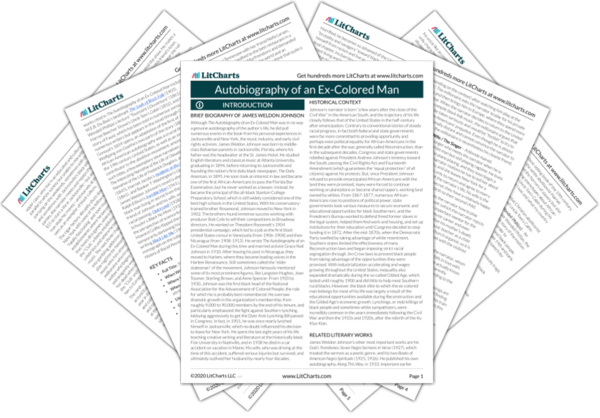Most obviously, clothes signify their wearers’ wealth and social status—as when the narrator’s father wears shiny shoes, the narrator himself dresses like “a little aristocrat” before starting school, and the rich widow and her companion are decked out in diamonds, but also when the losing dice players are forced to sell their own clothes and wear cheap replacements until they can win them back. Since the narrator is so perpetually enamored with wealth, other characters’ elegant clothes signal for him to emulate and respect them. Indeed, from his earliest days in Connecticut, the narrator felt he was distinguished because his mother dressed him well. Later, when the millionaire buys him expensive Parisian designs, the narrator sees this as an economic achievement that makes him his benefactor’s equal.
More importantly, clothes and jewelry also serve as an important metaphor for race and identity. In both cases, external appearances determine how one is viewed and interpreted by others, and especially what communities (of race and class, respectively) one is assumed to belong to. However, while race is ostensibly immutable—except perhaps in the narrator’s unique case—clothes are, to an extent, within people’s control: they signal how people see themselves as much as how the world is to see them. When Shiny speaks at the Connecticut school’s graduation ceremony, the narrator notes that his formal clothing “did not fit him any too well” and underlines the seriousness of his struggle against racism: the fact that he looks wrong in upper-class dress shows how dissonant it seems for blacks to live comfortably, and this social advancement is precisely what Shiny is fighting for. In his childhood, when his father visits him in Connecticut, the narrator cannot figure out who he is until he sees the shiny shoes and hat that remind him of the man from his childhood; these clothes stand in for what is, to everyone else, the narrator’s father’s most remarkable characteristic: his whiteness. More subtly, this points to the unequal relationship between the narrator’s parents: his mother was his father’s family’s sewing-girl, so his father’s beautiful clothes were in fact the product of his mother’s labor, just as white intergenerational wealth in the United States largely grew out of the value expropriated from black slave labor.
Clothing and Jewelry Quotes in Autobiography of an Ex-Colored Man
He made a striking picture, that thin little black boy standing on the platform, dressed in clothes that did not fit him any too well, his eyes burning with excitement, his shrill, musical voice vibrating in tones of appealing defiance, and his black face alight with such great intelligence and earnestness as to be positively handsome. […] I think there must have rushed over him a feeling akin to that of a gladiator tossed into the arena and bade to fight for his life. I think that solitary little black figure standing there felt that for the particular time and place he bore the weight and responsibility of his race; that for him to fail meant general defeat; but he won, and nobly.

Unlock explanations and citation info for this and every other Autobiography of an Ex-Colored Man quote.
Plus so much more...
Get LitCharts A+They filled the shops and thronged the sidewalks and lined the curb. I asked my companion if all the colored people in Atlanta lived in this street. He said they did not and assured me that the ones I saw were of the lower class. I felt relieved, in spite of the size of the lower class. The unkempt appearance, the shambling, slouching gait and loud talk and laughter of these people aroused in me a feeling of almost repulsion. Only one thing about them awoke a feeling of interest; that was their dialect. I had read some Negro dialect and had heard snatches of it on my journey down from Washington; but here I heard it in all of its fullness and freedom.












